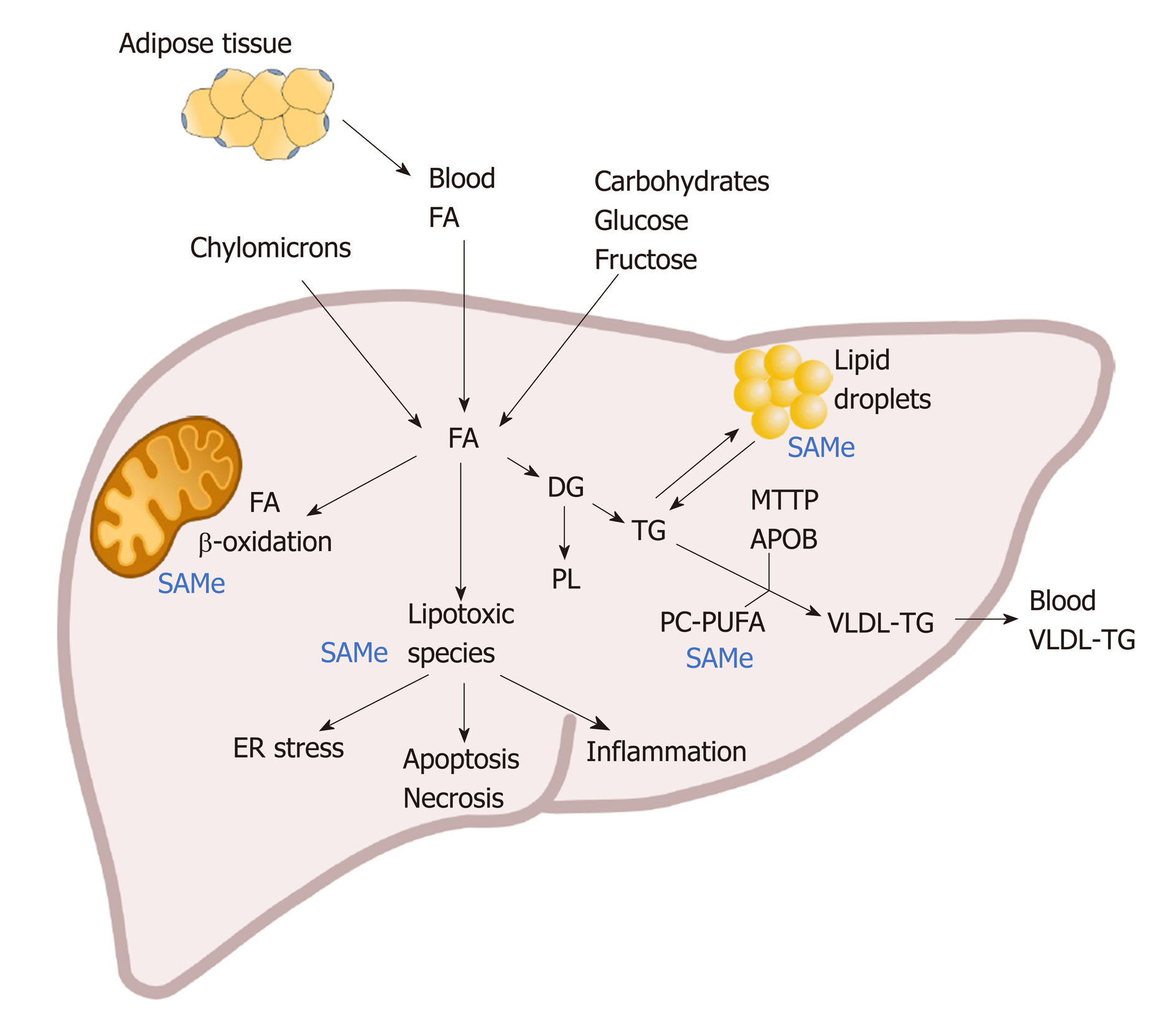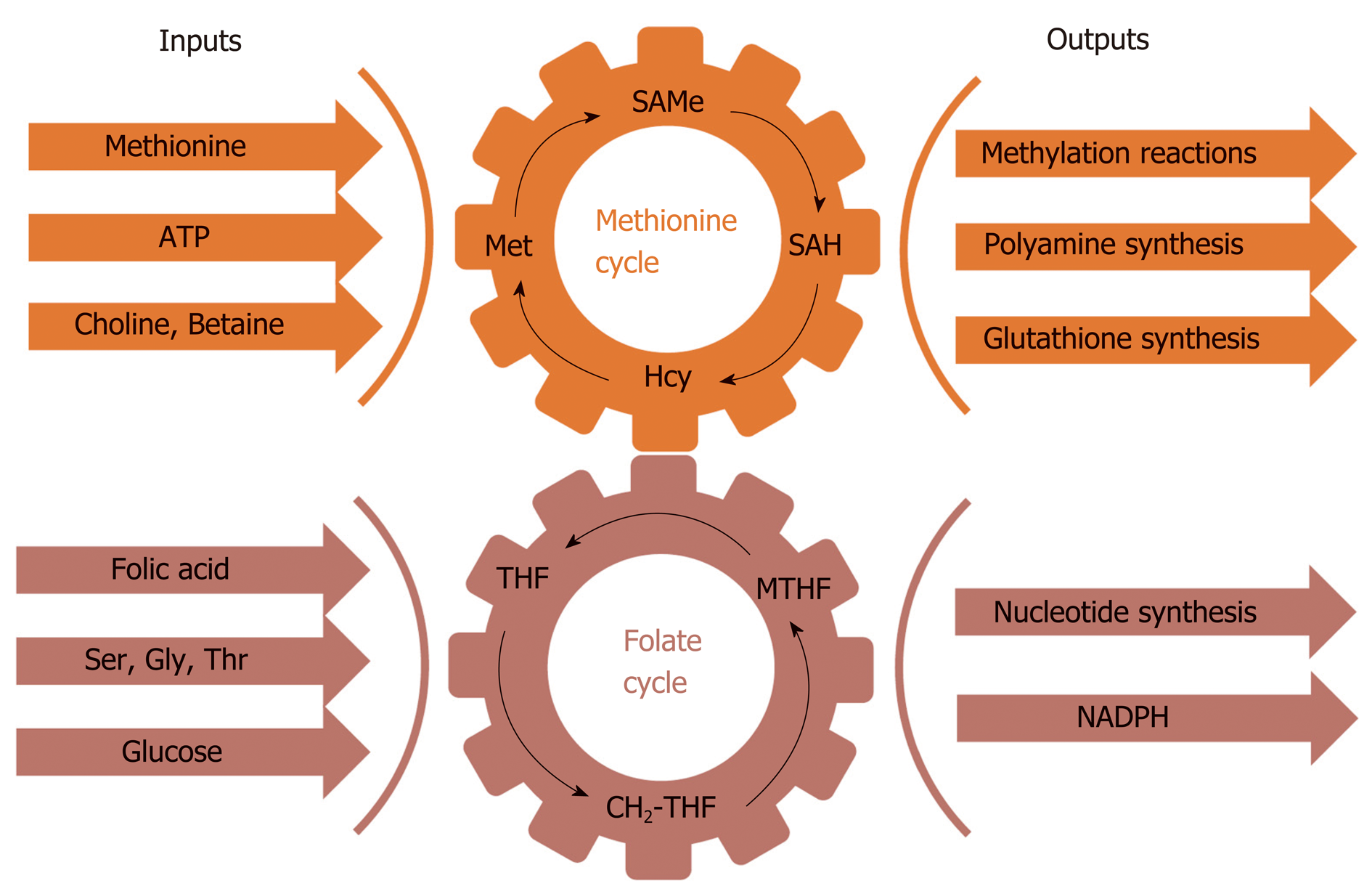Copyright
©The Author(s) 2019.
World J Gastroenterol. Jun 28, 2019; 25(24): 3009-3020
Published online Jun 28, 2019. doi: 10.3748/wjg.v25.i24.3009
Published online Jun 28, 2019. doi: 10.3748/wjg.v25.i24.3009
Figure 1 Lipid metabolism.
The mobilization of fatty acids (FA) from their triglyceride (TG) storage in the adipose tissue is promoted by TG lipases. The resultant FA are then released into the blood and taken up by hepatocytes. Other sources of hepatic FA are the dietary lipids in chylomicrons and de novo lipogenesis induced by carbohydrates. These FA are metabolized by mitochondrial or peroxisomal β-oxidation, accumulated in the cytoplasm inducing lipotoxicity, or subsequently elongated, desaturated and re-esterified for synthesis of complex lipids such us phospholipids (PL), diglycerides or TG. Some of the re-esterified TG are packed into very low-density lipoproteins combined with apolipoprotein-B and exported into circulation. This process is regulated by microsomal triglyceride transfer protein and accompanied by encapsulating the neutral lipid core with a PL monolayer enriched in phosphatidylcholine molecules containing polyunsaturated FA. Enzyme reactions regulated by S-adenosylmethionine (SAMe) and pathways in which SAMe deficiency may lead to the accumulation of TG and progression to nonalcoholic steatohepatitis are indicated in blue. APOB: Apolipoprotein-B; DG: Diglycerides; ER: Endoplasmic reticulum; FA: Fatty acids; MTTP: Microsomal triglycerides transfer protein; PC-PUFA: Phosphatidylcholines containing polyunsaturated fatty acids; PL: Phospholipids; SAMe: S-adenosylmethionine; TG: Triglycerides; VLDL: Very low-density lipoproteins.
Figure 2 Regulation of hepatic S-adenosylmethionine homeostasis.
Hepatic S-adenosylmethionine (SAMe) content is regulated by the concerted activity of methionine adenosyltransferase (MAT) and glycine N-methyltransferase (GNMT). Methionine is mainly metabolized by the liver where is converted to SAMe by the enzyme MAT using ATP as co-substrate. SAMe, the main cellular methyl donor, is converted to S-adenosylhomocysteine (SAH) by a legion of methyltransferases (MTs) that catalyze the methylation of multiple substrates (DNA, proteins, phospholipids, small molecules, toxic and waist products). Excess SAMe is catabolized by GNMT, the most abundant hepatic MT, to prevent undesirable methylations. The GNMT-sarcosine dehydrogenase (SDH) pathway recycles the excess of methyl groups via generation of methylene-tetrahydrofolate (CH2-THF) and the methylation of homocysteine to regenerate methionine (not shown) to maintain SAMe homeostasis. SAH is converted to homocysteine, a metabolic crossroad that can be used for the regeneration of methionine (not shown) or the synthesis of glutathione depending on whether the concentration of SAMe is low or high, respectively. SAMe is an allosteric activator of GNMT and an inhibitor of the re-synthesis of methionine via the CH2-THF pathway (broken lines). CH2-THF: 5,10-methylene-tetrahydrofolate; Gly: Glycine; GNMT: Glycine N-methyltransferase; MAT: Methionine adenosyltransferase; Me-Gly: Methylglycine (sarcosine); Me-R: Methylated product; MTs: Methyltransferases; MTHF: 5-methyltetrahydrofolate; R: Methylation substrate; SAH: S-adenosylhomocysteine; SAMe: S-adenosylmethionine; SDH: Sarcosine dehydrogenase; THF: Tetrahydrofolate.
Figure 3 Schematic representation of one carbon metabolism.
One carbon metabolism involves multiple physiological processes in which one carbon units circulate from different nutritional and amino acids inputs (choline, betaine, folic acid, glucose, methionine, serine, glycine and threonine), mediated by S-adenosylmethionine and 5-methyltetrahydrofolate, and are converted into a wide variety of outputs, such as the methylation of phospholipids, protein and DNA, and the synthesis of glutathione, polyamines, nucleotides, and reduced nicotinamide adenine dinucleotide phosphate. CH2-THF: Methylene tetrahydrofolate; Gly: Glycine; GSH: Glutathione; Hcy: Homocysteine; Met: Methionine; MTHF: 5-Methyltetrahydrofolate; NAPDH: Reduced nicotinamide adenine dinucleotide phosphate; SAH: S-denosylhomocysteine; SAMe: S-adenosylmethionine; Ser: Serine; THF: Tetrahydrofolate; Thr: Threonine.
- Citation: Mato JM, Alonso C, Noureddin M, Lu SC. Biomarkers and subtypes of deranged lipid metabolism in non-alcoholic fatty liver disease. World J Gastroenterol 2019; 25(24): 3009-3020
- URL: https://www.wjgnet.com/1007-9327/full/v25/i24/3009.htm
- DOI: https://dx.doi.org/10.3748/wjg.v25.i24.3009











